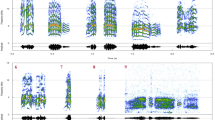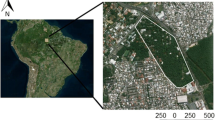Abstract
A few animal species are capable of vocal learning. Parrots are well known for their vocal imitation abilities. In this study, we investigated whether African grey parrots (Psittacus erithacus) emit specific vocalizations in specific contexts. We first described the vocal repertoire and its ontogenesis of four captive grey parrots. After a comparison with vocalizations emitted by wild and other captive African grey parrots, we observed that only three call categories were shared by all grey parrots populations, suggesting that isolated populations of parrots develop population-specific calls. Then, we artificially provoked ten different contexts and recorded vocalizations of four captive grey parrots in these situations. Parrots predominantly emitted call categories in some contexts: distress, protestation, alarm, asking (i.e. emitted when a bird wanted something from an experimenter) and contact calls. These results suggest that some calls are learned and can be used in specific contexts.


Similar content being viewed by others
Notes
Note that the recordings’ quality was not high, but good enough to identify salient call types.
References
Blumstein DT (1999) The evolution of functionally referential alarm communication: multiple adaptations; multiple constraints. Evol Com 3:135–147
Bradbury JW (2003) Vocal communication in wild parrots. In: de Waal FBM, Tyack PL (eds) Animal social complexity:intelligence, culture and individualized societies. Harvard Press, Cambridge, pp 293–316
Briefer E, Aubin T, Lehongre K, Rybak F (2008) How to identify dear enemies: the group signature in the complex song of the skylark Alauda arvensis. J Exp Biol 211:317–326
Burger J, Gochfeld M (2003) Parrot behavior at a Rio Manu (Peru) clay lick: temporal patterns, associations, and antipredator responses. Acta ethol 6:23–34
Colbert-White EN, Covington MA, Fragaszy DM (2011) Social context influences the vocalizations of a home-raised African grey parrot (Psittacus erithacus erithacus). J Comp Psychol 125(2):174–184
Crockford C, Boesch C (2003) Context-specific calls in wild chimpanzees, Pan troglodytes verus: analysis of barks. Anim Behav 66:115–125
Cruickshank AJ, Gautier JP, Chappuis C (1993) Vocal mimicry in wild African grey parrots Psittacus erithacus. Ibis 135:293–299
Evans CS (1997) Referential signals. Perspect Ethol 12:99–143
Evans CS, Evans L, Marler P (1993) On the meaning of alarm calls: functional reference in an avian vocal system. Anim Behav 46:23–38
Farabaugh SM, Dooling RJ (1996) Acoustic communication in parrots: laboratory and field studies of budgerigars, Melopsittacus undulatus. In: Kroodsma DE, Miller EH (eds) Ecology and evolution of acoustic communication in birds. Cornell University Press, Ithaca, pp 97–117
Farabaugh SM, Linzenbold A, Dooling RJ (1994) Vocal plasticity in budgerigars (Melopsittacus undulatus): evidence for social factors in the learning of contact calls. J Comp Psychol 108:81–92
Feher O, Wang H, Saar S, Mitra PP, Tchernichovski O (2009) De novo establishment of wild-type song culture in the zebra finch. Nature 459:564–568
Fischer J, Hammerschmidt K, Todt D (1995) Factors affecting acoustic variation in Barbary-macaque (Macaca sylvanus) disturbance calls. Ethology 101:51–66
Gautier JP, Cruickshank AJ, Chappuis C (1993) Vocal mimicry in wild African grey parrots Psittacus erithacus [sonograms recorded at Botsima, in the Salonga National Park, Zaire]. Annales-Musée Royal de l'Afrique Centrale. Sciences Zoologiques. Proceedings of the eighth Pan-African Ornithological Congress, Bujumbura (Burundi). 268:453–459
Giret N, Monbureau M, Kreutzer M, Bovet D (2009) Conspecific discrimination in an object-choice task in African grey parrots (Psittacus erithacus). Behav Proc 82:75–77
Giret N, Péron F, Lindová J, Tichotová L, Nagle L, Kreutzer M, Tymr F, Bovet D (2010) Referential learning of French and Czech labels in African grey parrots (Psittacus erithacus): different methods yield contrasting results. Behav Proc 85:90–98
Giret N, Roy P, Albert A, Pachet F, Kreutzer M, Bovet D (2011) Finding good acoustic features for parrot vocalizations: the feature generation approach. J Acoust Soc Am 129:1089
Goodale E, Kotagama S (2006) Context-dependent vocal mimicry in a passerine bird. Proc R Soc Lond B Biol Sci 73:875–880
Griffin AS (2008) Social learning in Indian mynahs, Acridotheres tristis: the role of distress calls. Anim Behav 75:79–89
Janik VM (1999) Pitfalls in the categorization of behaviour: a comparison of dolphin whistle classification methods. Anim Behav 57:133–143
Koenig SE, Wunderle JM, Enkerlin-Hoeflich EC (2007) Vines and canopy contact: a route for snake predation on parrot nests. Bird Cons Int 17:79–91
Laiolo P, Tella JL, Carrete M, Serrano D, López G (2004) Distress calls may honestly signal bird quality to predators. Proc R Soc Lond B Biol Sci 271:S513–S515
May DL (2004) The vocal repertoire of grey parrots (Psittacus eithacus) living in the congo basin. PhD Dissertation, University of Arizona, Tucson
May DL, Hovetter V, Gilardi J (2002) Where the wild greys are: a day in the life of Africa’s grey parrots. World Parrot Trust, Lake Alfred
Naguib M, Mundry R, Ostreiher R, Hultsch H, Schrader L, Todt D (1999) Cooperatively breeding Arabian babblers call differently when mobbing in different predator-induced situations. Behav Ecol 10:636–640
Pepperberg IM (1990) Cognition in an African gray parrot (Psittacus erithacus): further evidence for comprehension of categories and labels. J Comp Psychol 104:41–52
Pepperberg IM (1994) Vocal learning in grey parrots (Psittacus erithacus): effects of social interaction, reference, and context. Auk 111:300–313
Pepperberg IM (1999) The Alex studies: cognitive and communicative abilities of Grey parrots. Harvard University Press, Cambridge
Pepperberg IM (2006) Cognitive and communicative abilities of Grey parrots. Appl Anim Behav Sci 100:77–86
Pepperberg IM (2010) Vocal learning in Grey parrots: a brief review of perception, production, and cross-species comparisons. Brain Lang 115:81–91
Schmid R, Doherr MG, Steiger A (2006) The influence of the breeding method on the behaviour of adult African grey parrots (Psittacus erithacus). Appl Anim Behav Sci 98:293–307
Seddon N, Tobias JA, Alvarez A (2002) Vocal communication in the pale-winged trumpeter (Psophia leucoptera): repertoire, context and functionnal reference. Behaviour V 139:1331
Treisman M (1978) Bird song dialects, repertoire size, and kin association. Anim Behav 26:814–817
Yin S, McCowan B (2004) Barking in domestic dogs: context specificity and individual identification. Anim Behav 68:343–355
Acknowledgements
The authors thank Marie Monbureau for her suggestions on how to improve the manuscript. We also thank Syrina Al Aïn, Mathieu Amy, Julie Chébaux, Colette Désaleux, Violaine Garcia-Fernandez, Philippe Groué, Valériane Jouffroy, Philippe Lenouvel, Alexandre Lerch, Marie Monbureau and Solène de Sevin for taking care of the parrots. We thank Dr. Michel St-Jalme and Dr. Jacques Rigoulet for their authorization to record parrots of the “Ménagerie du Muséum d’Histoire Naturelle” of Paris. We also want to thank the private owners of parrots for their participation in this experiment: Claire Bougeret, Marie Brandewinder, Olympe Chazara, Véronique Cluzeau, Loïc Fougères, France Garachon, Sophie Himene, Marylène Juif, Nicolas Lagière, Sylvaine Piana, Jérémie Roussière, Delphine Le Roux and Catherine Tourasse. Funding for this research was provided by the 6th PCRD Nest Pathfinder “What it means to be human”. The experiments comply with the French laws concerning animal care.
Author information
Authors and Affiliations
Corresponding author
Rights and permissions
About this article
Cite this article
Giret, N., Albert, A., Nagle, L. et al. Context-related vocalizations in African grey parrots (Psittacus erithacus). acta ethol 15, 39–46 (2012). https://doi.org/10.1007/s10211-011-0106-9
Received:
Revised:
Accepted:
Published:
Issue Date:
DOI: https://doi.org/10.1007/s10211-011-0106-9




